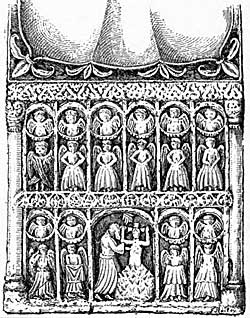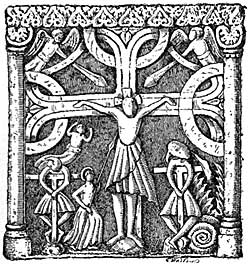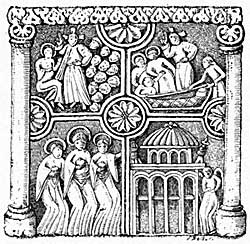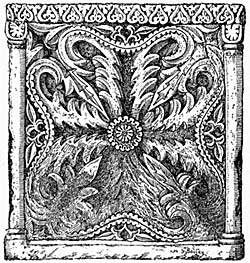< Previous
The font of Lenton Priory, Notts.
By George Bailey.

Side facing east.

Side facing south.

Side facing west.

Side facing north.
THIS fine font is now in use in the Church of the Holy Trinity at Lenton, a pleasant suburb of the town of Nottingham, which had been built and was consecrated in 1842, at which time the font, which had previously been in the garden of Lieut.-Colonel Stretton, was given to the new church by him. Lenton Priory dates from the reign of Henry I., 1100-1135. There are now no remains of the priory, except a base of one of the massive round pillars of the nave, and upon it three courses of the masonry, and this old font.
The drawings of the four sides and the curiously-shaped cavity for holding the water, which are here given, will show how valuable an example of font architecture it is even in its present state, after so many years of rough usage and exposure to the weather.
The side facing east has attached corner shafts with bases, and ornamented capitals supporting a band of ogee-shaped ornaments, and the front is divided into two parts by another band of similar design. The upper half forms an arcade of six arches; under each of those at the top is a row of cherub's, having below them festoons representing slashed cloth, which separates them from the row of angels below them. These latter appear to have been all of the same pattern, except that on the left side, which has a second pair of wings crossed above the feet. The next or lower half is divided into five spaces, the central one being larger, and having a representation of the baptism of our Lord in the Jordan by John the Baptist. The waters have risen into a conical heap, from the apex of which He is seen with hands uplifted and his head nimbed with a Greek cross. Above the two figures a hand projects from the clouds in benediction. The sculptured circles on the west door of Higham Ferrers Church, Northants, have a very similar representation of the Baptism scene, except that there are three figures, otherwise it is much the same, the principal figure rising from a similar conical heap of water. The two arches on the east side of this larger space are also filled with angels and cherubs like those above them, in the same order, except that the two immediately on each side of the central larger arch show the angels with napkins held before them, apparently for use when the Lord leaves the water.
Passing now to the south side, which is slightly narrower than the east and west sides, there is a representation of the Crucifixion. The cross is an ornamental one, each of the three upper members issuing from circles, behind which a part of the band- or strap-work joins and forms in each of the upper corners a heart-shaped space. In the extreme spaces of the two corners are angels swinging censers. The figure of our Lord is much larger than are those of the two thieves. The head has the same cross-shaped nimbus as have all the representations of Him on this font. The figures of the thieves are each shown on a tau-shaped cross, over the top of which their arms are seen clasping the central beam, their legs being crossed behind in one instance, and before in the other, with the toes resting on the raised mound out of which the cross issues, and a cap is drawn over their heads, hiding their faces. The souls of these men are seen departing from their bodies : the one on the right is ascending up towards heaven, but his on the left descends into the jaws of hell, represented by a monster with a large mouth armed with many very sharp teeth. On the right there is a figure with a round nimbus to the head, in flowing dress, piercing the side of the Crucified with a long spear. There are corner shafts, and an ornamental band at the top, as is the case with all the four sides.
Turning now to the west side, it is found to be divided by a cross into four quarters. The cross has a circle at its centre, in which is a large flower, and the arms terminate in similarly decorated half-circles, which are partly hidden by the corner shafts. Each of the spaces between the arms of the cross is occupied by a sculptured scene from the life of our Lord, but what scenes is not so easy to decide. The first space at top appears to show Him standing in the attitude of addressing a crowd of people, represented by a number of heads (these are on his left or behind him); on his right there is a seated figure. Can this represent the Ascension ? It has been said to be Christ before Pilate, but this seems scarcely to be an acceptable interpretation. Perhaps a reader may be able to supply the true one. The next, most likely, is the raising of Lazarus: Two men are removing the lid from a coffin in which lies a person bound with a trellis-work of bands; while our Lord and the two sisters—a fourth person supports one of them —stand by the side. This has been called the Resurrection, but it does not look like it. The two other quarters are of easy decision : first are the three Marys going to the tomb with their boxes of ointment for embalming; and next is the sepulchre, represented by a circular and ornate structure, near to which one of the attendant angels is seen.
The fourth or north side is entirely filled with a finely designed floral cross. No other ancient font bears on it anything so handsome as the design on this side of the Lenton font; it appears to be quite unique. Perhaps this was in the first instance the back of the font or west side, and not the north, as when these drawings were made. This, however, is only a conjecture, and may be wrong.
The shape of the basin is an irregular quatrefoil; the central foils are hollowed out to admit of the child being immersed, allowing the hands to hold it with greater ease while this was being done. There was originally a lid, and traces of the fastenings remain.
It remains now to say that the dimensions are as follows : It is 2 feet 6 inches in height; the east side 2 feet 10½ inches at the top and 2 feet 9¼ inches at bottom; probably this small difference arises from the edges being broken and weathered ; the north side is 2 feet 5 inches at the top—thus, there are two sides of the former size and two of the latter, namely, 5 inches narrower.
The font was originally coloured, either wholly or partially, the ground back of the women going to the tomb being red, and there is blue in the colonnade of the sepulchre. The basin or bowl is 30 inches by 26 inches, and 18 inches drop.
This font owes its preservation to the fact that it found its way into a gentleman's garden. Much has been said about such things being so basely used, but it might, and most likely would, have come to a much worse fate. Not a few have been buried or broken up to mend roads with; than this much rather should they adorn gardens, and be the receptacles for dainty flowers. But to break them up—ugh !
< Previous
